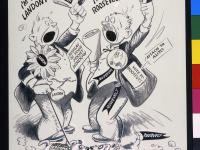Philadelphia, PA – Benjamin Franklin is credited with publishing the first American political cartoon in 1754, but he was also one of first American political figures to be lampooned by subsequent cartoonists. This demonstrates the vivacity of American political cartooning: even illustrious Founding Fathers are not spared the cartoonist’s pen.
The Historical Society of Pennsylvania (HSP) will celebrate our nation’s lively political discourse with a special document display featuring a selection of its most interesting and entertaining political cartoons, many produced by masters of American political cartooning. The display, titled “Drawn & Quartered,” opened on April 22 and continues through June 6.
About Drawn & Quartered:
The display highlights cartoons spanning the late 1700s to 1923 – from our nation’s founding through the Progressive Era. These cartoons cover a range of topics and political themes, including the struggles of the colonial United States, the Civil War, and local Philadelphia politics. Many of the cartoons portray well-known public figures while others will depict abstract forces or generic characters, such as a “drunkard” or ethnic stereotypes. Reflecting the evolution of the political cartoon genre, the selected cartoons will encompass a variety of visual styles, ranging from intricate scenes with a great deal of text to stark images with few or no words.
Many of the political issues of this period—slavery, territorial expansion, corruption, partisanship, electioneering—are represented in cartoons within HSP’s collections. These materials are visually striking, intellectually provoking, with tones often sardonic and acerbic. HSP’s Library holds an impressive collection of political cartoons and other graphic materials.
This display is part of a two-year project HSP has undertaken to enhance the searchability and value of its graphics materials to the public and scholars. These images will be encoded and ultimately contain clickable “zones”, allowing allow users to access pop-up text with contextual information about the people, places, and issues contained in each cartoon. These images and annotation will be available in our Digital Library and in a separate exhibit site
The documents will be on display during normal library hours, Tuesday through Friday, at the Historical Society of Pennsylvania at 1300 Locust Street in Philadelphia. The document display will run from April 22, through June 6, 2014. Please check www.hsp.org for more information about visiting hours. Reservations are not necessary. There is no fee; however, visitors are encouraged to make a donation. All proceeds will go toward the care and conservation of the 21 million historic documents held at HSP
This display also includes a special same-day printing offer: a print of every image from the “Drawn & Quartered” display will be available for purchase, with all orders placed before 4:45pm honored by the end of the day.
In addition to the on-site display, many cartoons will be digitized and available on HSP’s Digital Library.
Media are welcome to attend. For high-quality images suitable for publication or for more information about “Drawn & Quartered” please contact Vincent Fraley, Communications Manager, at 215-732-6200 ext. 233 or vfraley@hsp.org
About the HINT Project:
The Historical Society of Pennsylvania has begun a two-year project to enhance description and discovery of its graphics materials and promote the linking and sharing of content among institutions and scholars. This project was funded by a grant from the National Historical Publications and Records Commission’s (NHPRC) Innovation in Archives and Documentary Editing program. Known as "Historic Images, New Technologies" (HINT), the project will result in an update to HSP's digital image viewer and an online digital history exhibit to demonstrate the new viewer's capabilities.
In the course of developing the new image viewer, HSP will digitize 500 political cartoons. Users will ultimately be able to search for cartoons on specific topics, analyze individual cartoons in depth, and follow links between cartoons and related contextual material. This image tool will have a lasting effect on HSP's ability to manage and describe its digitized images and will make it easier for the public to access them. The project will also include educational resources for teachers and students, as well as descriptive content that will be shared among the wider digital community. The overall objective is to make archival graphics more accessible for online users and encourage other repositories to adopt the new tools and practices.
The 500 cartoons featured in the project will span American history from the colonial period through the Progressive Era and will represent a wide array of topics and situations. Many of the cartoons will portray well-known public figures like presidents and politicians, while others will depict fictional or generic characters, such as Uncle Sam or figures embodying ethnic stereotypes. Reflecting the evolution of the political cartoon genre, the selected cartoons will encompass a variety of visual styles, ranging from intricate scenes with a great deal of text to stark images with few or no words.
The cartoons will be encoded in XML following Text Encoding Initiative (TEI) P5 guidelines. This will enable project staff to create "zones" of each image that, when clicked on by a user, will display pop-up text containing editorial content and more information about the people, organizations, and events depicted. This encoding will also include Linked Open Data (LOD) relationships, which will enhance the discovery of HSP's images and create more opportunities for sharing data between HSP and other institutions.
About the Historical Society of Pennsylvania:
Founded in 1824 in Philadelphia, the Historical Society of Pennsylvania collects and shares the stories of Pennsylvania. It is home to some 600,000 printed items and more than 21 million manuscript and graphic items. Its unparalleled collections encompass more than 300 years of America’s history—from its 17th-century origins to the contributions of its most recent immigrants. The society’s remarkable holdings together with its educational programming make it one of the nation’s most important special collections libraries: a center of historical documentation and study, education, and engagement.

